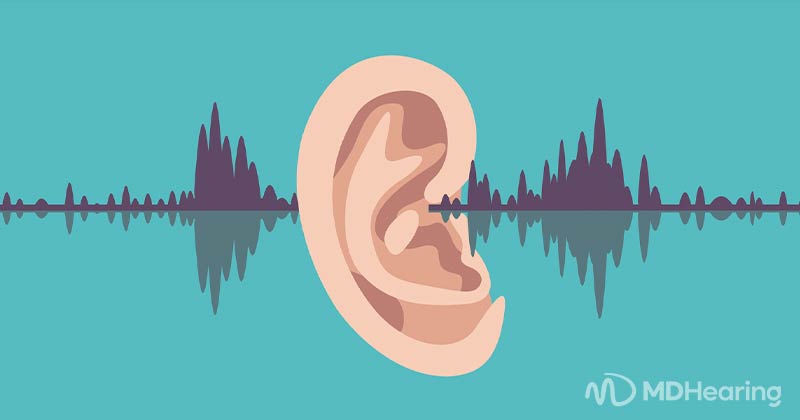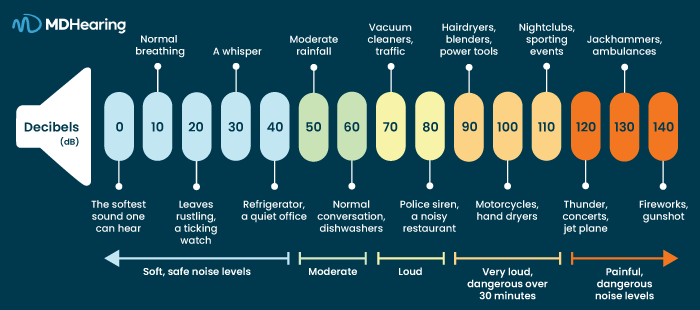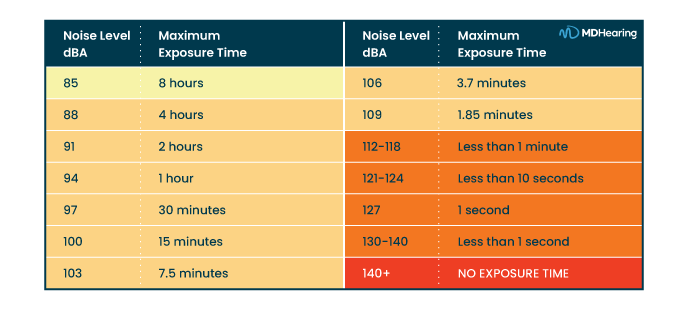The human ear is very sensitive, which is why you may find some sounds particularly uncomfortable or painful. It's common knowledge that a loud blast (such as fireworks) can cause hearing loss. However, you may not always be aware of just how loud some everyday sounds can be, such as a busy restaurant or a ball game.
In this article, we explain everything you need to know about the decibel chart, including what it is and how you can use it to be more aware of safe noise levels in your environment. We also offer tips on protecting your hearing from loud noise.
How Is Sound Measured?
To measure the intensity (noise level) of a sound, we use a measurement unit called a decibel (dB). Quite simply, the louder the sound, the higher the decibel number.
What Is a Decibel Chart?
A decibel chart shows the intensity levels of common environmental sounds, which range from 0 dB to 140 dB (the threshold of pain). Some points of reference on the decibel chart include the following:
- 0 dB - The softest sound a person can hear with normal hearing
- 10 dB - Normal breathing
- 20 dB - Leaves rustling, a ticking watch
- 30 dB - A whisper
- 40 dB - Refrigerator hum, a quiet office
- 50 dB - Moderate rainfall
- 60 dB - Normal conversation, dishwashers
- 70 dB - Vacuum cleaners, traffic
- 80 dB - Police car siren, a noisy restaurant
- 90 dB - Hairdryers, blenders, power tools
- 100 dB - Motorcycles, hand dryers
- 110 dB - Nightclubs, sporting events
- 120 dB - Thunder, concerts, a jet plane taking off
- 130 dB - Jackhammers, ambulances
- 140 dB - Fireworks, gunshot
Can Loud Noise Cause Hearing Loss?
High noise exposure can damage the delicate hearing hair cells in the ear, causing noise-induced hearing loss (NIHL). A one-time exposure to very loud noise, such as a firework blast close to your ear, can cause NIHL. More often though, hearing loss develops over time from repeated exposure to loud noise.
Since noise-induced hearing loss often occurs gradually, those affected may not realize until the damage is already done. Some symptoms of NIHL include difficulty understanding speech and needing to turn the volume up on the television.
A-Weighted Sound Levels
When comparing sound levels of different noises and their potential for causing hearing damage, A-weighted decibels (dBA) are often used instead of dB.
The main difference is that the dBA measurement takes into account the sensitivity of the human ear to different frequencies of sound. It places more value on frequencies in the middle of human hearing and less value on low and very high frequencies.
What Are Safe Decibel Levels?
The U.S. Environmental Protection Agency (EPA) and the World Health Organization (WHO) recommend maintaining environmental noises below 70 dBA over 24 hours to prevent NIHL.
Any sound at or above 85 dBA could cause damage to your hearing over time. Loud noise above 120 dBA is particularly dangerous and can cause immediate harm to your ears.
A general rule of thumb is if you are speaking to someone at arm's length and need to raise your voice for them to hear you, the noise level in the environment is probably above 85 dB and could cause damage to your hearing over time.
Safe Exposure Times for Different Noise Levels
To minimize NIHL in the workplace, The National Institute for Occupational Safety and Health (NIOSH) recommends that the work environment should be no louder than 85 dBA over 8 hours. It is mandatory to wear hearing protection when working around noise levels of 85 dBA and above.
For every increase of 3 dBA, the sound intensity doubles. Therefore, for every 3 dBAs, the recommended exposure time halves. NIOSH gives the following recommendations on how long it is safe to be around different continuous noise levels without wearing hearing protection:
| Noise Level dBA | Maximum Exposure Time |
|---|---|
|
85 dBA
|
8 hours
|
|
88 dBA
|
4 hours
|
|
91 dBA
|
2 hours
|
|
94 dBA
|
1 hour
|
|
97 dBA
|
30 minutes
|
|
100 dBA
|
15 minutes
|
|
103 dBA
|
7.5 minutes
|
|
106 dBA
|
3.7 minutes
|
|
109 dBA
|
1.85 minutes
|
|
112-118 dBA
|
Less than 1 minute
|
|
121-124 dBA
|
Less than 10 seconds
|
|
127 dBA
|
1 second
|
|
130-140 dBA
|
Less than 1 second
|
|
140+ dBA
|
NO EXPOSURE TIME (threshold of pain)
|
Comparing the decibel chart with the NIOSH guidelines can help us determine whether we could be damaging our hearing due to exposure to noisy environments. For example, the decibel chart tells us that a concert is routinely 120 dB, and NIOSH recommends less than 10 seconds of exposure time to this level of sound. This is a clear indicator that we should be taking steps towards protecting our hearing when spending time in this level of noise.
How to Protect Your Hearing From Dangerous Noise Levels
Loud noises are everywhere and often go hand-in-hand with socializing or recreational activities such as concerts and sporting events. Yet, the damage caused to your ears from exposure to such levels of excessive noise can be permanent.
The good news? Noise-induced hearing loss (NIHL) is entirely preventable. There are several ways you can protect your ears from damage due to loud noise.
The World Health Organization (WHO) recommends you take the following steps to help protect your hearing:
- Keep the Volume Down: For sounds that you can control, such as watching the TV or using headphones, be mindful of volume levels. If it seems too loud, it probably is: Turn it down!
- Walk Away From Loud Sounds: If you are not able to control the volume of a sound, you can instead move away from the sound source. For example, at concerts, you can distance yourself from the speakers.
- Limit Your Time Spent in Loud Environments: If you must be in noisy environments for prolonged periods, be sure to take breaks from the noise to limit your exposure time.
- Wear Hearing Protection: If you work in a noisy environment such as a factory or construction site, you should use effective hearing protection. The most common types of protection are earplugs, earmuffs, or noise-canceling headphones. You can also wear hearing protection at concerts and sporting events. Musicians' earplugs are specifically engineered to reduce the loudness levels while maintaining the quality and clarity of the sound, so you won’t miss out on the performance.
- Have Regular Hearing Tests: Testing your hearing regularly means you can monitor your hearing levels to identify and treat any issues early on.
Concerned about your hearing?
Our free online hearing test only takes 5 minutes, and you get immediate results! Once you’re done, MDHearing’s on-staff licensed hearing professionals will be available to discuss your results and walk you through the best options for your needs.
Start by taking our quick and easy online hearing test now.
TAKE ONLINE HEARING TEST


